The danger signal, extracellular ATP, is a sensor for an airborne allergen and triggers IL-33 release and innate Th2-type responses
- PMID: 21357533
- PMCID: PMC3062674
- DOI: 10.4049/jimmunol.1003020
The danger signal, extracellular ATP, is a sensor for an airborne allergen and triggers IL-33 release and innate Th2-type responses
Abstract
The molecular mechanisms underlying the initiation of innate and adaptive proallergic Th2-type responses in the airways are not well understood. IL-33 is a new member of the IL-1 family of molecules that is implicated in Th2-type responses. Airway exposure of naive mice to a common environmental aeroallergen, the fungus Alternaria alternata, induces rapid release of IL-33 into the airway lumen, followed by innate Th2-type responses. Biologically active IL-33 is constitutively stored in the nuclei of human airway epithelial cells. Exposing these epithelial cells to A. alternata releases IL-33 extracellularly in vitro. Allergen exposure also induces acute extracellular accumulation of a danger signal, ATP; autocrine ATP sustains increases in intracellular Ca(2+) concentration and releases IL-33 through activation of P2 purinergic receptors. Pharmacological inhibitors of purinergic receptors or deficiency in the P2Y2 gene abrogate IL-33 release and Th2-type responses in the Alternaria-induced airway inflammation model in naive mice, emphasizing the essential roles for ATP and the P2Y(2) receptor. Thus, ATP and purinergic signaling in the respiratory epithelium are critical sensors for airway exposure to airborne allergens, and they may provide novel opportunities to dampen the hypersensitivity response in Th2-type airway diseases such as asthma.
Figures
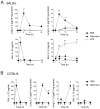
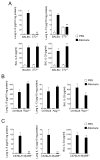
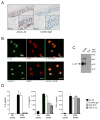
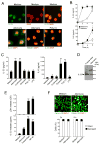
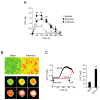
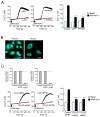
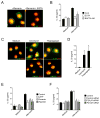
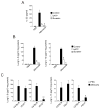
Similar articles
-
Airway uric acid is a sensor of inhaled protease allergens and initiates type 2 immune responses in respiratory mucosa.J Immunol. 2014 May 1;192(9):4032-42. doi: 10.4049/jimmunol.1400110. Epub 2014 Mar 24. J Immunol. 2014. PMID: 24663677 Free PMC article.
-
IL-33 and thymic stromal lymphopoietin mediate immune pathology in response to chronic airborne allergen exposure.J Immunol. 2014 Aug 15;193(4):1549-59. doi: 10.4049/jimmunol.1302984. Epub 2014 Jul 11. J Immunol. 2014. PMID: 25015831 Free PMC article.
-
House dust mite allergens induce interleukin 33 (IL-33) synthesis and release from keratinocytes via ATP-mediated extracellular signaling.Biochim Biophys Acta Mol Basis Dis. 2020 May 1;1866(5):165719. doi: 10.1016/j.bbadis.2020.165719. Epub 2020 Feb 7. Biochim Biophys Acta Mol Basis Dis. 2020. PMID: 32044300
-
Allergens and the airway epithelium response: gateway to allergic sensitization.J Allergy Clin Immunol. 2014 Sep;134(3):499-507. doi: 10.1016/j.jaci.2014.06.036. J Allergy Clin Immunol. 2014. PMID: 25171864 Review.
-
Airway epithelial regulation of pulmonary immune homeostasis and inflammation.Clin Immunol. 2014 Mar;151(1):1-15. doi: 10.1016/j.clim.2013.12.003. Epub 2013 Dec 14. Clin Immunol. 2014. PMID: 24503171 Review.
Cited by
-
Interleukin-33 in health and disease.Nat Rev Immunol. 2016 Nov;16(11):676-689. doi: 10.1038/nri.2016.95. Epub 2016 Sep 19. Nat Rev Immunol. 2016. PMID: 27640624 Review.
-
Mechanisms and Rationale for Targeted Therapies in Refractory and Unexplained Chronic Cough.Clin Pharmacol Ther. 2021 Mar;109(3):619-636. doi: 10.1002/cpt.2003. Epub 2020 Aug 28. Clin Pharmacol Ther. 2021. PMID: 32748976 Free PMC article. Review.
-
Alternaria induces STAT6-dependent acute airway eosinophilia and epithelial FIZZ1 expression that promotes airway fibrosis and epithelial thickness.J Immunol. 2012 Mar 15;188(6):2622-9. doi: 10.4049/jimmunol.1101632. Epub 2012 Feb 10. J Immunol. 2012. PMID: 22327070 Free PMC article.
-
Alternaria-induced release of IL-18 from damaged airway epithelial cells: an NF-κB dependent mechanism of Th2 differentiation?PLoS One. 2012;7(2):e30280. doi: 10.1371/journal.pone.0030280. Epub 2012 Feb 7. PLoS One. 2012. PMID: 22347372 Free PMC article.
-
Hepatic pannexin-1 mediates ST2+ regulatory T cells promoting resolution of inflammation in lipopolysaccharide-induced endotoxemia.Clin Transl Med. 2022 May;12(5):e849. doi: 10.1002/ctm2.849. Clin Transl Med. 2022. PMID: 35593197 Free PMC article.
References
-
- Cookson W. The immunogenetics of asthma and eczema: a new focus on the epithelium. Nat Rev Immunol. 2004;4:978–988. - PubMed
-
- Holt PG, Macaubas C, Stumbles PA, Sly PD. The role of allergy in the development of asthma. Nature. 1999;402:B12–17. - PubMed
-
- Lambrecht BN, Hammad H. Biology of lung dendritic cells at the origin of asthma. Immunity. 2009;31:412–424. - PubMed
Publication types
MeSH terms
Substances
Grants and funding
- R01 AI034486/AI/NIAID NIH HHS/United States
- HL095811/HL/NHLBI NIH HHS/United States
- R56 DK074010/DK/NIDDK NIH HHS/United States
- R56 AI034486/AI/NIAID NIH HHS/United States
- AI34486/AI/NIAID NIH HHS/United States
- R21 HL095811/HL/NHLBI NIH HHS/United States
- AI49235/AI/NIAID NIH HHS/United States
- R01 AI034486-15/AI/NIAID NIH HHS/United States
- R01 AI071106/AI/NIAID NIH HHS/United States
- DK074010/DK/NIDDK NIH HHS/United States
- R56 AI049235/AI/NIAID NIH HHS/United States
- R01 HL110539/HL/NHLBI NIH HHS/United States
- R29 AI034486/AI/NIAID NIH HHS/United States
- R01 AI049235-04/AI/NIAID NIH HHS/United States
- R01 AI071106-04/AI/NIAID NIH HHS/United States
- R01 AI049235/AI/NIAID NIH HHS/United States
LinkOut - more resources
Full Text Sources
Other Literature Sources
Molecular Biology Databases
Miscellaneous

